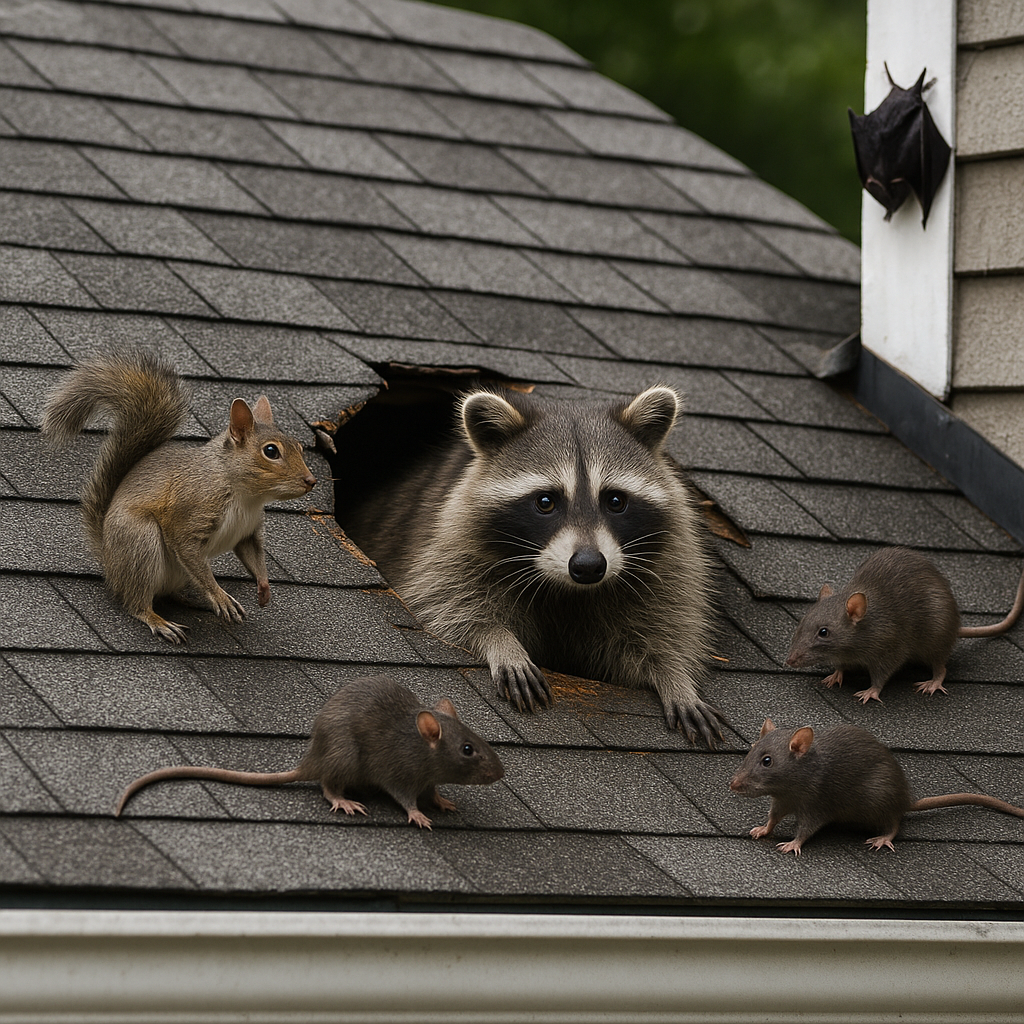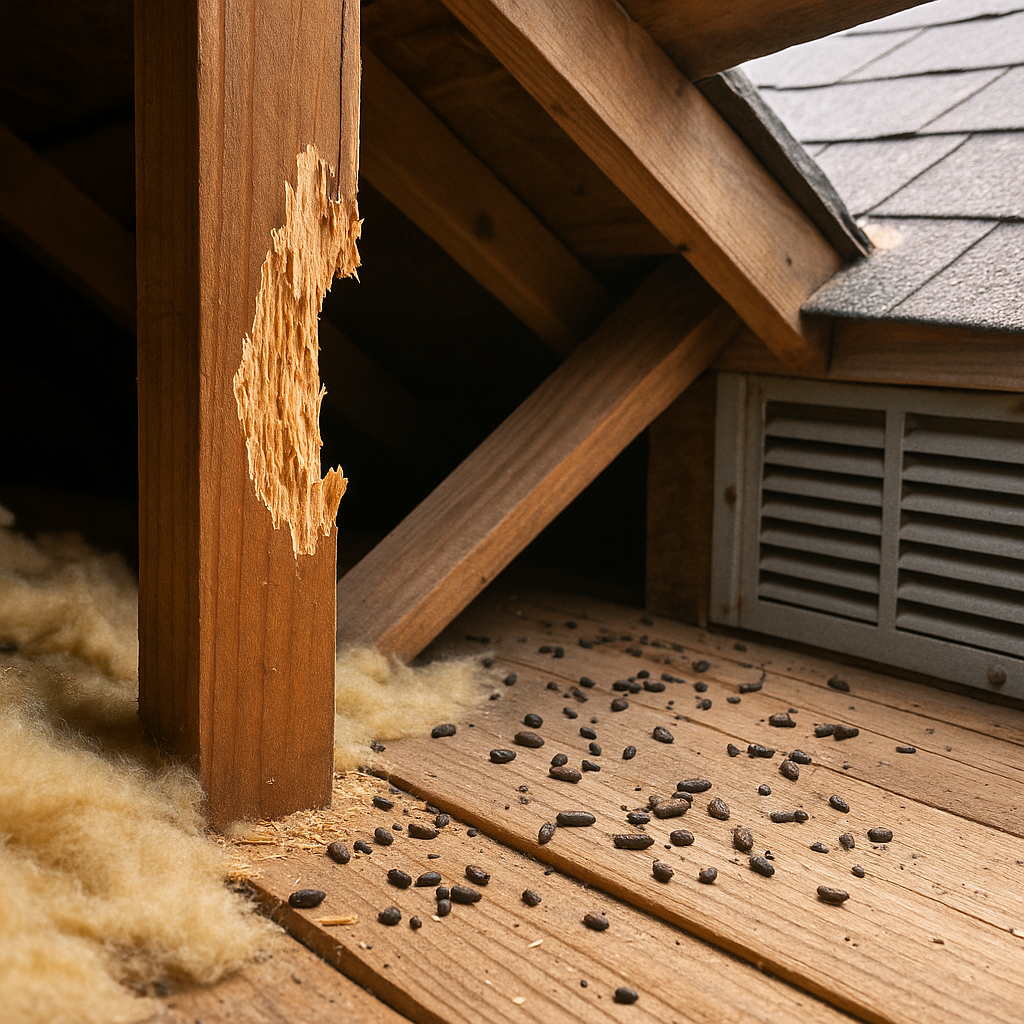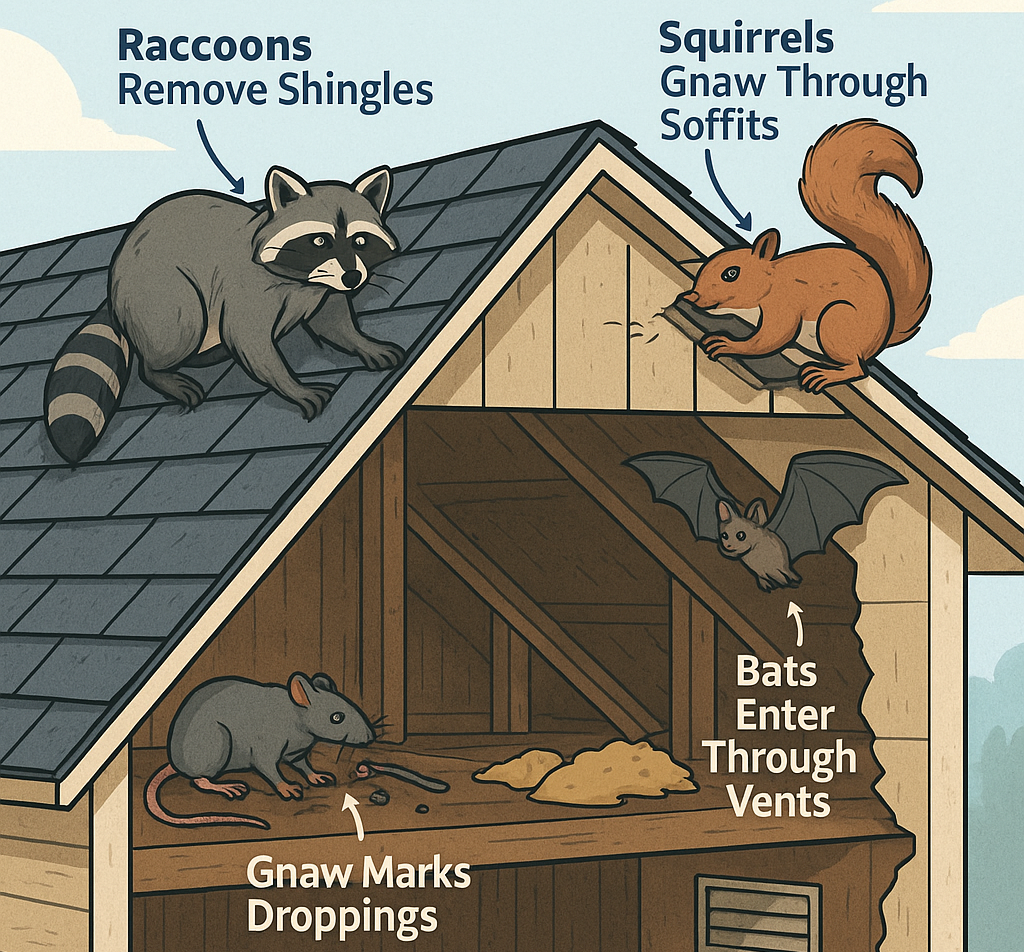Yes, critters can indeed come through the roof, sneaking into our attics and causing significant trouble. Animals like raccoons, squirrels, and bats exploit gaps in soffits, loose shingles, and damaged vents, leaving telltale signs like gnaw marks and droppings. Once inside, they create structural damage by chewing through materials and may even pose fire risks by attacking wiring.
Prevention strategies, such as regular inspections and sealing entry points, are essential in keeping them out. Knowing how animals gain access and the damage they cause is vital if we’re to outsmart these pesky intruders and protect our homes.
Identifying Animal Presence
As homeowners, it’s essential we stay vigilant for signs of uninvited critters in our attics. These animals can cause substantial animal damage if their presence goes unnoticed. By understanding the signs of animals in our attic space, we can act quickly to mitigate roof damage and protect our homes. Nocturnal scratching noises are often the first clue, signaling that something has made its way into our attic. Visible droppings or nesting materials, like shredded insulation or paper, can also indicate an infestation.
Let’s not overlook potential entry points—these are vital in identifying where animals might be accessing our attic. Oily residues around entry areas are a telltale sign, pointing to frequent animal traffic. Gnaw marks on wood or insulation often suggest a rodent problem, while unpleasant animal odors, particularly from raccoons or bats, demand immediate attention. Regular inspections of our attic space are essential to catching these signs early. By staying alert to these indicators, we can prevent extensive, costly damage to our roofs and maintain a safe, healthy home environment, free from the hazards of unwanted critters.
Common Entry Points

We can’t afford to overlook the common entry points that animals use to invade our attics. These attic invaders, including common pests like squirrels and raccoons, often find their way inside through vulnerabilities in our roofing systems. To protect our homes, let’s examine the typical entry points these critters exploit:
- Soffits and Eaves: These areas can develop gaps from weather or age, providing easy access for wildlife.
- Gable Vents: Often overlooked during exterior inspections, they can become damaged areas that invite pests if screens are torn or missing.
- Roof Returns: Improper installation or wear can create openings, allowing larger animals to slip through.
- Loose Shingles: Even minor shifts can create openings large enough for rodents, like mice, to enter.
Our close friend Bill Ball at BB Roofing Solutions always reminds homeowners that, “Regular exterior inspections are essential for identifying these entry points before they become a problem. Damaged areas, such as compromised flashing or holes from previous animal activity, need immediate attention.”
Brent and his team have helped countless homeowners seal up vulnerable roof areas and prevent wildlife from turning attics into homes. Their roofing expertise and local reputation make them a top choice in Bluffton and beyond.
Types of Intruding Animals
When it comes to attic invaders, we often find ourselves dealing with a variety of critters, each with its own unique way of causing chaos. Raccoons, with their strong climbing abilities, are known for tearing through shingles to gain access to your attic, creating significant entry points. Squirrels, on the other hand, can’t resist gnawing on roofing materials, often damaging insulation and creating holes in soffits. These types of intruding animals don’t just stop at causing physical damage; their presence poses serious health risks as well.
Bats seek the dark, quiet spaces of attics for roosting, and while they may seem harmless, their droppings can wreak havoc on wood and insulation, not to mention the health threats they pose. Rodents like rats and mice are notorious for slipping through the tiniest openings, gnawing on electrical wires and structural elements, leading to potential fire hazards. Even birds, though often overlooked, can build nests in attics and chimneys, obstructing ventilation and causing various complications.
Understanding these invaders and their methods of entry helps us take proactive measures to protect our homes from damage and maintain a healthy living environment.
Damage Caused by Wildlife

Wildlife can often wreak havoc on our homes, especially when they find their way into attics. These animals exploit weaknesses in our roofing, such as torn shingles or gaps in eaves, leading to significant damage. Once inside, the damage they cause can be extensive and varied:
- Structural Damage: Animals like squirrels and raccoons gnaw on beams and insulation, compromising the attic’s structural integrity and increasing fire hazards due to exposed wiring. If you suspect your electrical system has been affected, we highly recommend reaching out to our trusted partners at Live Oak Electrical for a thorough safety inspection and any necessary repairs. Their expertise in serving Hilton Head Island homes ensures your electrical systems are safe and up to code after any critter-related damage.
- Roofing Material Deterioration: Birds and bats leave behind acidic droppings, which can wear down roofing materials, resulting in costly repairs and mold issues.
- Energy Inefficiency: When rodents contaminate ductwork and degrade insulation, our energy costs can soar due to inefficiencies and heat loss.
- Ventilation Obstruction: Wildlife nests can block ventilation systems, leading to reduced airflow and potential damage to HVAC components.
Prompt detection is vital to mitigate these issues. By understanding the potential damage animals can cause, we can take necessary actions to protect our homes. It is important to address these vulnerabilities swiftly to maintain the safety and efficiency of our living spaces.
Prevention Techniques
Understanding the damage wildlife can inflict on our homes highlights the significance of taking proactive measures. By implementing effective prevention techniques, we can protect our attics and roofing systems from critter invasions. First, it’s essential to regularly inspect your attic and roof. This helps us identify and seal potential entry points, such as gaps in soffits, eaves, and around vents, before they become welcome mats for wildlife.
One of the simplest yet most effective methods is to trim overhanging tree branches. These branches often act as highways for squirrels and raccoons, providing easy access to our roofs. By keeping them trimmed, we reduce the risk of these animals finding their way into our attics.
Another key step is to clean gutters frequently. Clogged gutters can attract birds and other wildlife looking for nesting spots, increasing the likelihood of roof damage. We often hear from our friends at Gutter Xperts, who specialize in professional gutter cleaning, that neglecting this simple task is one of the most common causes of unwanted animal activity on roofs. In addition, removing climbing vines and dense vegetation near our homes prevents critters from using them as ladders to reach rooftops.
Lastly, consider using non-toxic repellents and installing barriers like squirrel guards. These additional defenses help keep our roofing systems secure, ensuring a safe and efficient home environment.
Removal Strategies
As soon as we discover critters in our attic, it’s essential we act quickly and efficiently to address the issue. Employing effective removal strategies not only protects our home but also guarantees these animals are handled humanely.
We spoke with Jake at Wildthingz LLC, “The longer animals stay in your attic, the more damage they’ll do—and the harder it becomes to remove them safely. Early action is the key to protecting both your home and the wildlife.”
- Wear Protective Gear: Before attempting any removal, we should don protective gear to safeguard against diseases and injuries from animal droppings and nesting materials. This step is critical for our health and safety.
- Use Humane Methods: Live trapping is a humane method we can use to capture and relocate critters, complying with local laws regarding protected wildlife. This guarantees we handle the situation ethically and legally. Always check your state’s regulations before attempting removal—South Carolina has specific rules for handling wildlife, outlined by the South Carolina Department of Natural Resources (SCDNR).
- Seal Entry Points: Once the animals are removed, it’s essential we seal all entry points using durable materials like steel. This prevents re-infestation and protects our roofing system from further damage.
- Clean Thoroughly: To eliminate odors and health risks, we must thoroughly clean areas affected by the presence of animals. Removing droppings and nesting materials restores our attic to a healthy state.
Chris and his team are trusted throughout the Lowcountry for their humane, professional, and effective wildlife removal services. By working with a seasoned expert like Chris, you gain peace of mind knowing the problem is resolved safely, legally, and thoroughly.
Insurance and Cost Considerations
Maneuvering the maze of insurance and cost considerations when dealing with animals in our attics can save us from unexpected financial strain. First, it’s essential to understand that insurance coverage for wildlife-related damage varies widely. Some policies don’t cover damages from infestations, leaving us responsible for the cost of repairs. Consulting with an insurance broker can clarify our specific policy clauses related to wildlife removal and damage coverage. This step guarantees we’re not caught off guard by gaps in our insurance.
Cost estimates for animal removal and repair can range from a few hundred to several thousand dollars, influenced by the type of animal, extent of infestation, and required repairs. Documenting any infestations and resultant damage is critical for potential insurance claims. Thorough records can streamline the claims process and improve the likelihood of reimbursement. Additionally, local wildlife laws may affect our removal options and costs, especially if protected species are involved.
Let’s not wait for the telltale sounds of unwanted guests above us.
By understanding how critters exploit our roofs and recognizing the signs of their presence, we can take proactive steps to protect our homes. Regular inspections, sealing entry points, and employing humane removal strategies are key. Investing time and effort now prevents costly damage and health risks later. Together, we can safeguard our attics and enjoy peace of mind under a secure roof.

